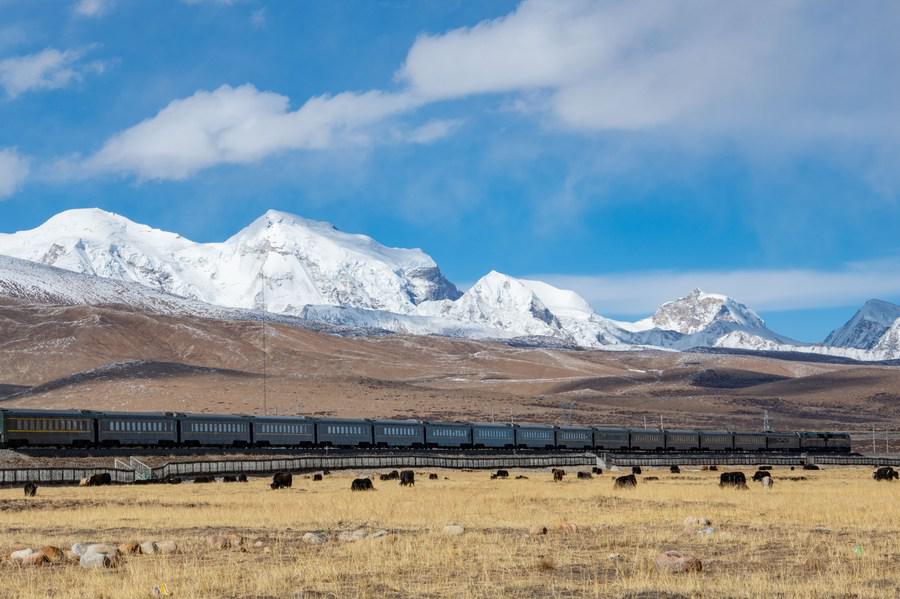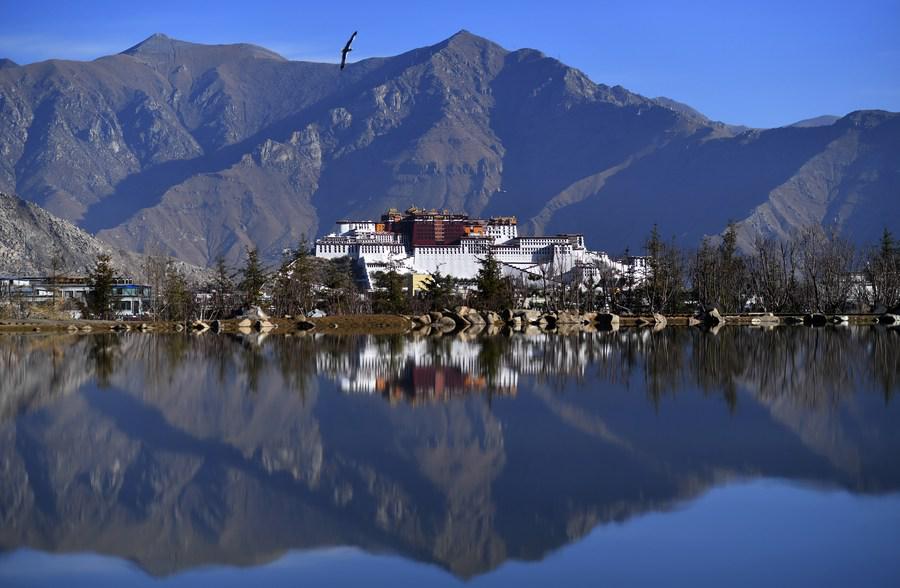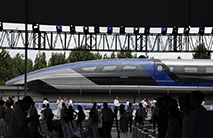Plateau railway propels Tibet's development to new heights

A train running on the Qinghai-Tibet Railway passes by the Nyainqentanglha Range in southwest China's Tibet Autonomous Region, March 1, 2020. (Xinhua/Purbu Zhaxi)
LHASA/XINING, July 22 (Xinhua) -- Sangye Puncog, 22, never saw a train until his high school graduation tour to Lhasa, capital of southwest China's Tibet Autonomous Region.
Fascinated by the "steel giant," Sangye Puncog, a Tibetan hailing from the rural Nyingchi City, was inspired to major in transportation and went on to study at Southwest Jiaotong University.
Financially aided by the government, he graduated in 2019 and is now in charge of passenger loading and unloading at the Golmud Railway Station, a railway hub in Qinghai Province neighboring Tibet.
"I didn't know I would work here when I passed through it on a train to the university," Sangye Puncog said with a smile.
In July 2006, the railway section connecting Golmud and Lhasa went into operation, marking the opening of the world's highest and longest plateau railroad -- the Qinghai-Tibet railway.
The railway, the first connecting Tibet with the rest of China, has stimulated the development of the plateau region by bringing tourists, materials, and business opportunities.
By the end of June, the railway transported 29.63 million passengers and 68.35 million tonnes of cargo from and to Tibet, according to the China Railway Qinghai-Tibet Group Co., Ltd.
Hu Xiaodi, a 57-year-old tourist, headed for Lhasa on the Z6801 train. He and five of his relatives planned to hire a car in Lhasa for a road trip in Tibet.
"Tourism in Tibet is so popular that we can hardly book enough tickets for us to the Potala Palace," said Hu, from the city of Suzhou, Jiangsu Province.
Tibet received 1.8 million tourists from home and abroad in 2005, one year ahead of the opening of the landmark rail link. It received more than 35 million tourists in 2020 despite the impact of COVID-19.
Due to the unavailability of train tickets to Lhasa because of high demand, Ma Yuxiu, who was traveling with her four-year-old daughter, had to transfer twice from Xining, the capital of Qinghai and starting point of Qinghai-Tibet railway. She was there to meet her husband, who is a crane driver and has worked at different construction sites in Tibet for three years.
"Considering that he is too busy, we have to meet him every year and travel around," said Ma, 26, adding that they have visited several destinations in Tibet like the Potala Palace and the Yumzhog Yumco Lake.

Photo taken on March 12, 2021 shows the Potala Palace in Lhasa, capital of southwest China's Tibet Autonomous Region. (Xinhua/Chogo)
Built at an altitude of more than 4,500 meters, the Nagqu railway station in the city of Nagqu is the world's highest railway station combining passenger and cargo transportation.
The annual number of passenger trips handled by the railway station surged from 16,000 in 2006 to 310,000 in 2020.
"The waiting hall, which opened to the public in 2006, is so small that many passengers have to stand during peak season," said Dong Shenggang, head of the station.
The station handled 518,000 tonnes of cargo in 2020, skyrocketing by 619 percent from 2006.
"Construction materials such as steel, cement, timber, as well as daily necessities like grains and salt have been among the major goods delivered up here," Dong said.
The Chinese central government made a cumulative investment of 1.63 trillion yuan (about 253 billion U.S. dollars) in the 70 years after the peaceful liberation of Tibet, showed figures released in May.
Over 590 billion yuan of the total investment went into the construction of major projects that have significantly driven the region's economic development, including the Sichuan-Tibet Highway and Qinghai-Tibet Railway.
The region's gross domestic product soared to more than 190 billion yuan in 2020 from 34.2 billion yuan in 2006.
Xu Guoming, who had just left Lhasa by train for Xining, is amazed by the mushrooming buildings and infrastructure projects in Lhasa.
The entrepreneur in truck transportation from east China's Shandong Province first came to Lhasa in 2013.
"Compared with my first trip there, I could hardly recognize the street I had lived in," said Xu, 42, adding that he is optimistic about his business prospects in Tibet.
To meet the rising demand for passenger transport, the old Golmud station measuring 500 square meters has been replaced by a new one covering nearly 15,000 square meters. It can accommodate 2,000 passengers in the waiting hall at the same time.
The Golmud station worker Sangye Puncog is also delighted as a new railway section connecting Lhasa and his hometown Nyingchi went into operation last month.
The 435-km line, the first electrified railway in Tibet, has shortened the travel time between Nyingchi and Lhasa to three and a half hours from some seven hours by bus.
Arranged by Sangye Puncog, his father, a rice farmer, took a train trip for the first time in his life to Lhasa. His mother, who was then in poor health, did not go.
"I'm planning to take my mother on board a train when I'm on vacation. My parents are proud of me," he said.
Photos
Related Stories
Copyright © 2021 People's Daily Online. All Rights Reserved.










